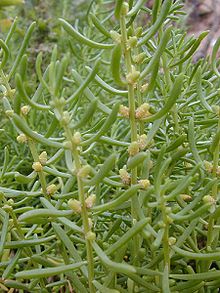| Batis maritima | |
|---|---|

| |
| Scientific classification | |
| Kingdom: | Plantae |
| Clade: | Tracheophytes |
| Clade: | Angiosperms |
| Clade: | Eudicots |
| Clade: | Rosids |
| Order: | Brassicales |
| Family: | Bataceae |
| Genus: | Batis |
| Species: | B. maritima
|
| Binomial name | |
| Batis maritima | |
| Synonyms[1] | |
| |
Batis maritima, the saltwort or beachwort (also known as turtleweed, pickleweed, barilla, planta de sal, camphire, herbe-à-crâbes, and akulikuli-kai[2]), is a halophyte. It is a C3-plant, long-lived perennial, dioecious, succulent shrub. The plant forms dense colonies in salt marshes, brackish marshes, and mangrove swamps and frequently is found on the margins of saltpans and wind-tidal flats.[3] Batis maritima is a pioneer plant, covers quickly areas where hurricanes have destroyed the natural vegetation.
So far, Batis maritima has not been used commercially for food production but the seeds have a high oil content with high nutritional value.[4]
- ^ "The Plant List: A Working List of All Plant Species".
- ^ Francis, John K. (2004). Francis, John K. (ed.). Wildland Shrubs of the United States and Its Territories: Thamnic Descriptions: Volume 1 (PDF). U.S. Department of Agriculture, Forest Service. pp. 107–109.
- ^ Lonard, Robert I.; Judd, Frank W.; Stalter, Richard (2011). "The Biological Flora of Coastal Dunes and Wetlands: Batis maritima C. Linnaeus". Journal of Coastal Research. 27 (3): 441–449. doi:10.2112/JCOASTRES-D-10-00142.1. S2CID 85230854.
- ^ Massimo F. Marcone, 2003. "Batis maritima (Saltwort/Beachwort): a nutritious, halophytic, seed bearings, perennial shrub for cultivation and recovery of otherwise unproductive agricultural land affected by salinity" Food Research International 36:123-130